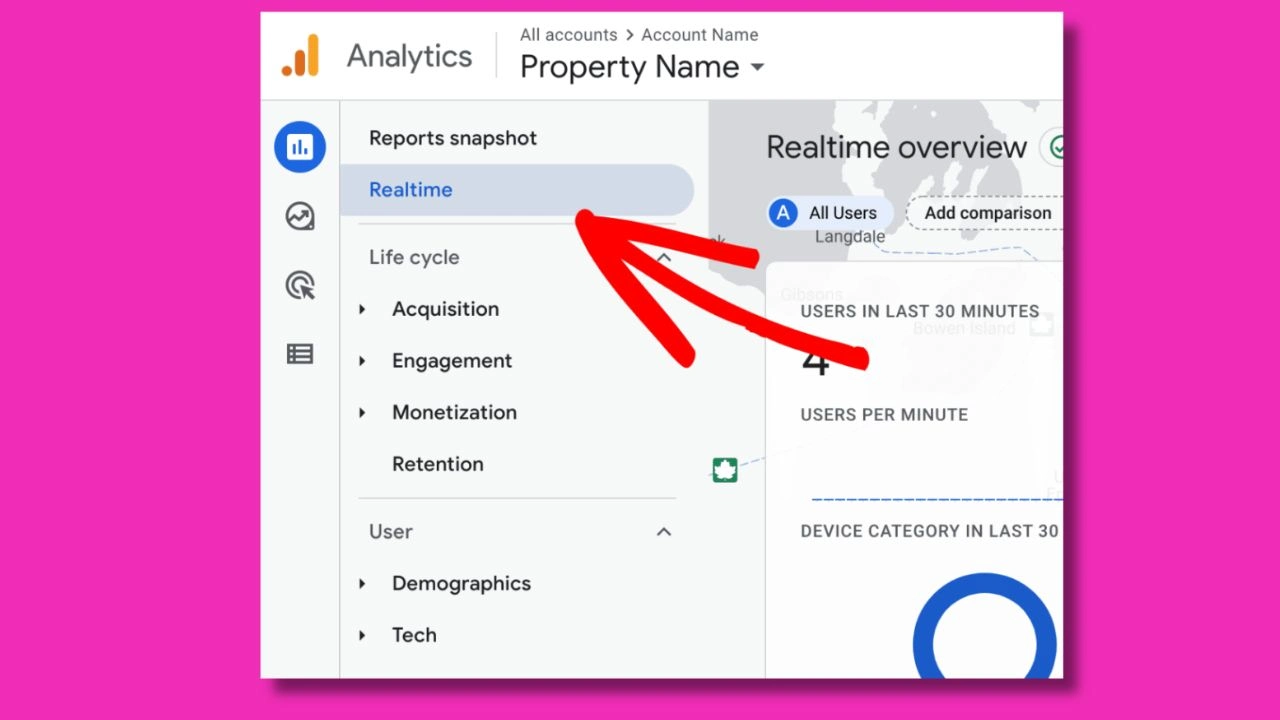Now, with an ever-evolving world where digital marketing and website analysis take the lead, almost all businesses need to keep real-time reports. They can know how Google Analytics will provide real-time reports, showing what is occurring on your site and all interesting happenings. It gives the businesses perfect sense for the benefit of their users: active users, the actions they perform, plus their impacts from campaigns, content, and design modifications on the website. The major concern then is: Which events are accounted for in the realtime report?
This blog will discuss the different areas where information is being poured into the real-time report and how one can use the report to make well-informed decisions on their website performance. Further, we would glance at how services like Google Analytics consulting services might help elevate this even further regarding using these reports.
What Exactly is a Real-Time Report in Google Analytics?
Before focusing on those events that real-time reports keep track of, let’s understand which events are accounted for in the realtime report means and why it might be important. Google Analytics offers a real-time report that shows how many active users are currently on your website, from where they enter, the pages they visit, and the actions they take currently.
Such reports are immensely beneficial to businesses since they help businesses practically understand how users are interacting with their website. Whether you are running a marketing campaign or you’ve just launched a new feature, real-time reports present instant feedback that helps track trends and problems immediately.
What Events Are Accounted for in the Real-Time Report?
Looking at real-time reports in Google Analytics, you will immediately see many interesting events being recorded. These events would give instant insight into how users are engaging your site at a particular moment. Let’s run through the major events in the real-time report.
Pageviews
It is one of the most elementary yet important events that capture data from real-time reports. This event catches a page view every time a user visits one of the pages of your site. If you happen to live in a highly frequented site where multiple individuals browse multiple pages simultaneously, then pageviews would tell which real-time accessed pages are the most visited. Again, you can analyze how visitors move through your site to improve the student experience.
Active Users
Even in the real-time report, one of the metrics being captured is active users. This tells the number of people currently viewing your website at that particular point in time. For businesses that run promotional campaigns or have launches and want to monitor traffic, this is real-time data to the max. It lets you know how a particular campaign is performing at that given moment.
For example, if you are with a Website redesign agency launching a new design for your website, you can monitor active users while the launch of your new site is happening. If the number of active users spikes, then you know that your marketing is working.
The Performance of Individual Pages
Another which events are accounted for in the realtime report is the performance of individual pages. Google Analytics can show you which pages users are currently seeing. It would help track the performance of the respective content, landing pages, or any newly published articles being highlighted. With knowledge of the page that performs well, you can refine your marketing efforts further.
For example, if you own a travel website development company, you would be able to check the real-time performance of particular travel destination pages, so you could tweak content instantly.
Traffic Sources
Real-time reporting includes traffic sources, which show how your users enter your website: from organic search, paid ads, social media, or direct visits. This data can be especially useful for companies running multiple campaigns and trying to learn how their audience finds their site.
When working with a b2b web design agency to generate targeted leads through certain marketing channels, one can witness if the real-time traffic source report shows their efforts to be immediately paying off.
Events and Conversions
An event is a user action that does not always result in a pageview yet constitutes an interaction with your website, such as clicking some buttons, viewing a video, submitting a form, or downloading a file. When businesses have configured certain goals or triggers on their website, the corresponding events will show up in real-time reports.
An easier way to do this is if you have Google tag management consulting services integrated so that you have real time tracking of granular events like clicking on a button or submitting the form and measuring their impact.
E-Commerce Activity
For e-commerce websites, real-time reports monitor e-commerce events, including views, add-to-cart actions, and completed purchases. Such information increases the value of its owners by informing them about the level of engagement from users toward their products within the site. It allows monitoring real-time e-commerce activities so that business owners can evaluate the achievement of sales in no time.
If you are operating an online store for a travel website development company, it matters how many users are adding items to their carts and checking out in real time for conversion optimization.
Locations and Devices
Another which events are accounted for in the realtime report is the location of your users, including their geographical locations and the kind of devices they are using. This event is useful to observe if any traffic spikes have occurred in a particular region, and whether users are accessing your website more through mobile devices or desktops.
Businesses can leverage this information to possibly adjust their website design or content. For instance, if a large number of users are using mobile devices to access your site, then you may want to partner with a website redesign agency to consider mobile usability.
The Importance of Real-Time Reports for Businesses
In this way, establishments gain instant insights on more than just the conversions, site issues, and promotion successes that they need to remedy, or the excitement and buzz real-time reports provide can narrow the choices for data integration into more specific optimizations.
In fast-moving sectors or promotional sales, the ability to generate real-time reports can make or break the speed and precision by which companies adapt to situations and take countermeasures.
Maximizing Real-Time Reporting
The real-time reports can benefit your website when it is integrated into a broader analytics strategy. Partnering with Google analytics consulting services can help companies set up advanced tracking systems to ensure the information they get is the most relevant to them.
Meanwhile, establishing a Google analytics audit checklist guarantees that your reporting speaks to your business goals and tracks the right metrics.
Conclusion: Unlocking Real-Time Analytics
Thus, which events are accounted for in the realtime report provide businesses with the whereabouts of events and performance tracking as they occur. Be it tracking active users or traffic sources, or e-commerce activities, these reports provide instant insights into a website’s performance. The user would be in a position to maximize the use of real-time data significantly and optimize the site for realizing better results by integrating analytics tools and using the expertise of a Website Redesign Agency.
If you’d like to maximize the performance of your website maintenance services, you can contact a Google Tag Management Consulting Services provider to improve your tracking setup. Any event tracked on which events are accounted for in the realtime report could greatly influence improving user experiences and enhancing conversions.
FAQs
Which Events Are Accounted for in the Real Time Report in Google Analytics?
Real-Time Reports in Google Analytics and the Events That Are Considered
As an advanced tool, Google Analytics real-time reports allow you to find out what is happening on your website at this very moment. It provides instant data into user engagements whereby you monitor and analyze visitor behavior as it happens. So, which events are accounted for in the realtime report? Such events generally consist of actions by users such as page views, clicks, form submissions, and other interactions being tracked with event tags or other analytics setups.
Some of the events tracked include:
- Page Views: Any visit to a new page on the website by a user will be deemed an event.
- Clicks: Event tracking set up for buttons or links will track these events in the real-time report.
- Downloads: Where download links exist, a click on the link will also be counted as an event.
- Video Plays: Lifting the cover on sites with embedded video, the initiation of the video playback could be captured as an event.
- E-Commerce Actions: E-commerce sites track events such as adding items to the shopping cart and purchasing.
When events are factored into real-time reports, it allows you to capture user engagement instantly and get a clear picture of how content performs in the moment.
What Can You Investigate in a Real-Time Report?
Real-time reports in Google Analytics provide insights into what users are doing on your website at this very moment. Google Analytics allows you to track real-time data on your audience to enable quick reactions to user behavior. The following are examples of some of the classic content of the real-time report:
- Active Users: Number of people on your website at that second.
- Traffic Sources: Where your visitors are coming from, organic search, direct links, or referral links.
- Top Active Pages: The most viewed pages at that moment.
- Locations: Geographical location of active users, which tells you from which countries or cities users are accessing your website.
- Event Tracking: The events happening in real-time (clicks, form submissions, video plays, etc.)
- Conversions: If tracking conversions (sign-ups, purchases) have been set up, these conversions occur in real-time.
When consulting Google Analytics, you may customize your real-time reports to portray precisely that data that you need, thus ensuring that you are checking the most important events for your business.
Understand What Real-Time Report Display
What Does the Real-Time Report Show?
A real-time report gives you live activity on your website to get insights at the moment. It includes –
- Current Page Views: Shows which pages the users are currently browsing.
- User Engagement: Indicates particular events happening, such as button clicks, form submissions, etc.
- Traffic Breakdown: Where the users came from (via organic search, paid search, social media, etc.).
- User Locations: Shows the geographical location of active users.
In addition, Google Tag Management Consulting Services can help you set up event tracking which allows you to monitor detailed actions such as clicks on specified buttons, video views, or other user interactions in real-time. Hence, this will allow you to immediately adjust them to enhance the user experience.
What Are Event Counts in Google Analytics?
Event counts are counted in Google Analytics where event refers to the number of occurrences of an event. An event occurs whenever a user interaction is tracked by and into Google Analytics. When a user uses a button to download an e-book, that event will count under the event.
Event counts are significant in showing the frequency of events being performed on your site. The real-time report updates event counts instantly in order to track how frequently some events are occurring. Such counts have been proven useful for insights into user behavior regarding which actions on your site attract the most engagement.
For example:
- Event counts will display clicks on the buy now button in real time.
- In the same way, if you are tracking form submissions, you are going to see how many users are filling out forms on your website at that moment.
- This is what event count tracking does in Google Analytics. It helps companies to assess how effectively their sites are performing at real-time collection of actions taken in key interactions with the users.






Leave a Reply